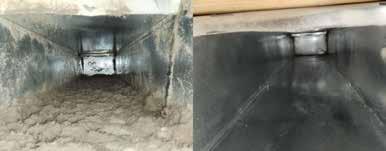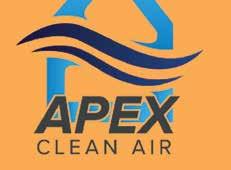

Bold colors and big stories at Los Muros on Main
By Peri Kinder | peri.k@thecityjournals.com
Eight muralists will contribute their talents to Midvale’s mural festival.
Each year, the Los Muros on Main: Midvale City Mural Festival transforms Midvale’s Historic Main Street into a vibrant open-air gallery, featuring live mural painting by local artists and world-renowned muralists.
The main event starts on Saturday, June 7, from 4-9 p.m. in the Midvale Main Arts & Culture District (7505 Holden St.) as the free, family-friendly celebration of public art and culture showcases talent and brings the community together.
“We are doing eight murals this year and they’re spread throughout the entire street,” said Aubrey Ruiz, Midvale’s community development executive assistant. “The artists are very communicative. They will be at their walls, being able to talk and explain their inspiration and where their design came from, which is an awesome experience. And there are activities all up and down the street.”
Utah craft brewery, 2 Row Brewing, will serve its popular drinks and host a beer garden during the event, featuring games like cornhole and spike ball. Live bands will perform at separate locations along the street, providing a lively soundtrack for the festival.
A vendor marketplace will offer 30 booths that highlight local goods, original artwork and unique crafts, and food trucks can be found on the new plaza north of Midvale City Hall, featuring delicious favorites from local chefs.
This is the festival’s fourth year and interest is growing from muralists around the world. Ruiz said it’s become a fun challenge to go through the applications and select artists that fit into Midvale’s vibe.
“We have a selection committee that’s made up of internal staff, city council members, local artists and local business owners, so we get multiple points of view,” she said. “We look at the experience that the artist has had, and we have them submit examples of their work. Then we pair them with the donated walls as best as we can, with what the business owner has suggested for their desired type of work to go on their wall.”
Muralists create the murals in the week leading up to the festival and finish their paintings during the event. Visitors can
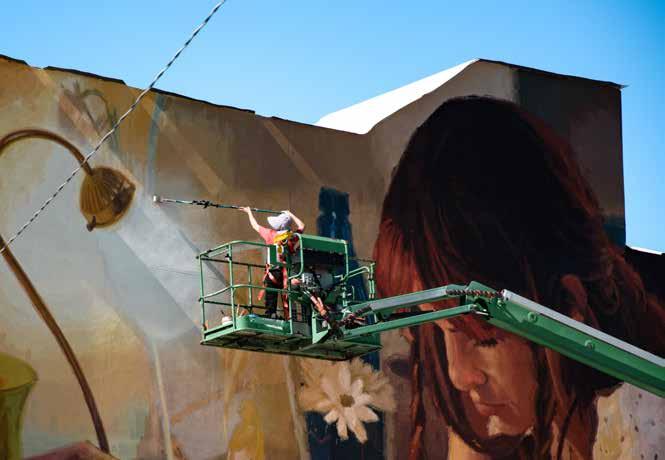
talk to each muralist and watch them create artistic magic on the walls of the district.
Mayor Dustin Gettel hosts a lead-up event to the festival on Thursday, June 5 from 6-7 p.m. Everyone is invited to meet at Midvale City Hall (7505 S. Holden St.) for free ice cream, then walk the street to tour the murals with the mayor. For more info, visit EngageMidvale.com.
“Los Muros on Main is a reflection of what makes Midvale special; bold creativity, meaningful connections, and a deep pride in our diverse community,” Gettel said. “We’re proud to welcome artists from around the world to add their voices to the vibrant story we’re already telling on Main Street.” l


Megan Oldhues finishes her mural “By Lamplight” during last year’s Los Muros on Main in Midvale. This year, artists will add eight murals to local buildings on Saturday, June 7. (Photo courtesy of Midvale City)
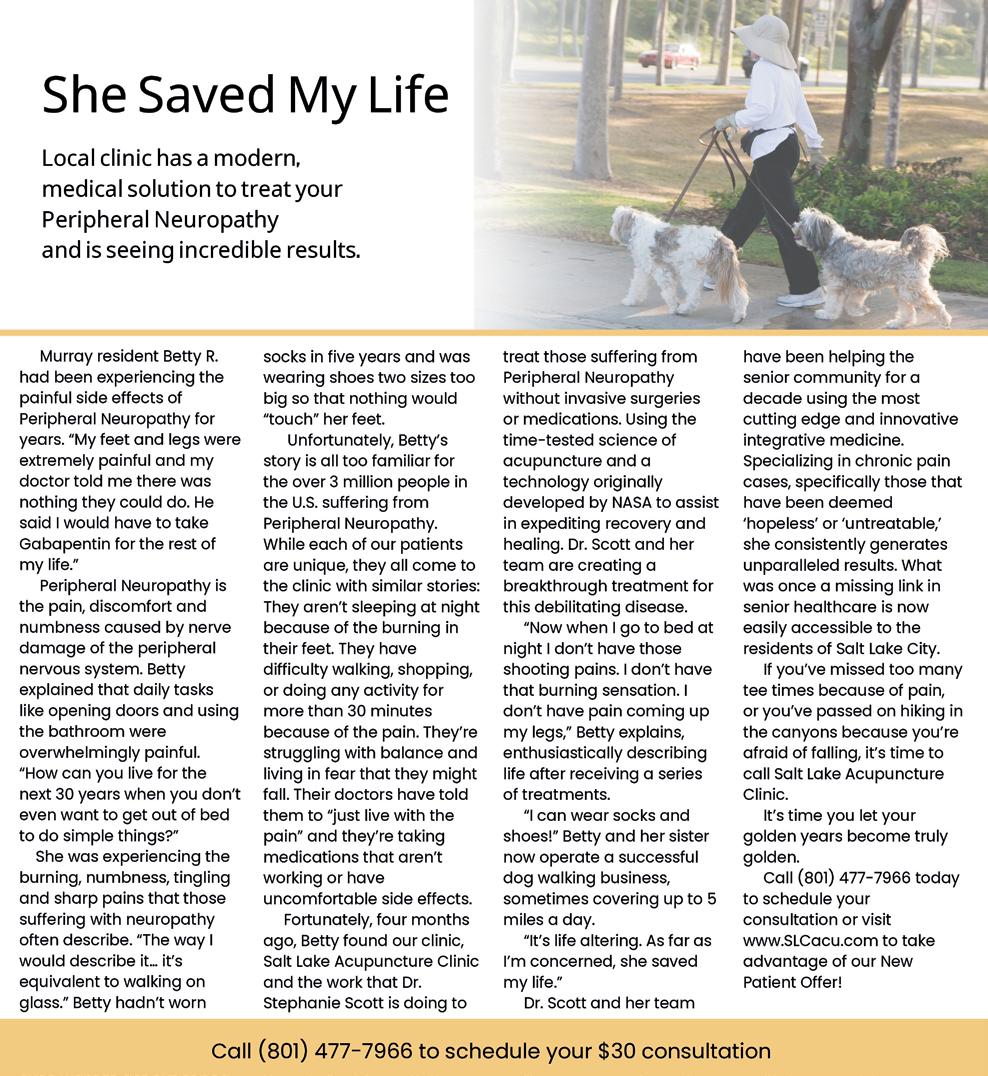
Enjoy a Safe, Healthy, Active Summer
By Vincent Giron, DO
With summer here and everyone wanting to spend time outdoors and to be more active, there are four important health and safety tips that I recommend for all age groups and activity levels.
1. Stay hydrated. The No. 1 priority for summer safety is proper hydration before and after activity. Drinking lots of water and reducing the amount of caffeinated drinks is crucial for hydration. Adding electrolytes such as sports drinks is also helpful while avoiding excess sugar. Zero sugar or diet electrolyte sports drinks and hydration packs are an easy way to do this.
2. Use sunscreen. Sunscreen is crucial not only for skin health but can help with hydration as well. Sunburns put you at higher risk for dehydration. Applying sunscreen and reapplying frequently especially while swimming, playing sports, and hiking keeps your skin healthy and protected. Being conscientious about sun exposure helps prevent skin cancer, wrinkles, skin
discolorations and will help to keep your skin looking and feeling young.
3. Wear a helmet. Summer is a great time to go outdoors riding bikes, scooters and other fun activities while getting exercise. But anytime we bike, scoot, skate or participate in any riding activity, it is imperative to wear a helmet. No matter how short your ride is, you need to protect your brain. It only takes one fall or accident to cause permanent brain damage or life-long disability.
4. Stretch. People of all ages and activity levels from youth sports to the weekend warrior need to be stretching before and after activity. In the summer it is easy to skip the warm-up when exercising or playing sports because the warmer temperatures make us feel ready to go; however our muscles are still tight and are just as prone to injury as in the colder months. Taking the time to warm up by gradually stretching our muscles not only helps prevent injury but promotes muscle building and endurance. Stretching is especially im-
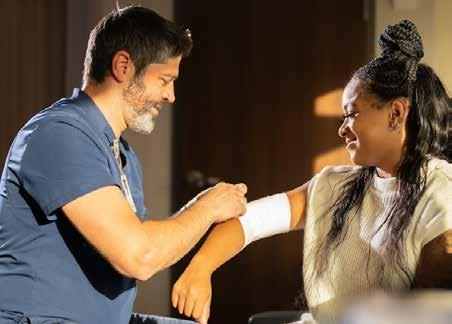

1-303-673-8166 (TTY: 711).
portant for elderly individuals. Stretching also helps reduce aches and pains as well as improve mobility and stability, which decrease the risk of falls.
Exercise is important for all ages. Summer is a great time to increase your level of activity. Exercise, especially outdoors, promotes physical as well as mental health and wellbeing. I hope we can all get outside, spend time with family and friends, and most of all, stay safe and healthy!
Dr. Vincent Giron is a CommonSpirit Health family medicine physician specializing in sports medicine. He is accepting new patients. His clinic is located at CommonSpirit Primary Care & Sports Medicine West Valley at 3336 S. 4155 W., Ste. 102 in West Valley. Phone:801-964-3925. He accepts most insurances.
Learn more about the services, care providers and missiondriven work of the Holy Cross hospitals and CommonSpirit Health at www.holycrossutah.org.


At CommonSpirit Health, we make the healing presence of God known in our world by improving the health of the people we serve, especially those who are vulnerable, while we advance social justice for all.
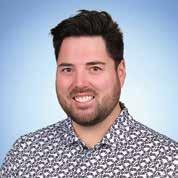
When minutes count, count on our emergency care.
Get to know us before you need us.
When you need emergency care fast, the closest emergency room is a smart thing to know. You never know the level of care you’ll need when an emergency happens and choosing the right ER can make all the difference. And a hospital ER comes with the confidence of additional services right on-site.
CommonSpirit Holy Cross Hospital – Salt Lake has been awarded Chest Pain Center Accreditation from the American College of Cardiology (ACC). Facilities that achieve accreditation meet or exceed an array of stringent criteria for evaluating, diagnosing and treating patients who may be experiencing a heart attack.
Find emergency care close to you at mountain.commonspirit.org.
SPONSORED CONTENT
Dr. Vincent Giron, DO
CommonSpirit Primary Care & Sports Medicine West Valley
Raise the Future builds a bridge to belonging
Youth in foster care are connected to mentors, guardians and adoptive families.
By Peri Kinder peri.k@thecityjournals.com
Raise the Future has a simple but powerful goal: ensure each young person has at least one caring adult they can count on. It doesn’t seem like much, but accomplishing that goal makes a measurable difference to children aged 14-21, who often struggle as they age out of the state’s foster system.
About 1,500 children in Utah fall into this category, but Raise the Future, a nonprofit focused on finding permanent homes for youth, provides support through family services and community engagement.
“The kids we work with are not just passing through the foster care system, they are growing up there. They are transitioning from home to home. We can have kids who have been in foster care for 12 years and have been through 22 different homes,” said Raise the Future Vice President of Development Lindsay Kaeding. “How are they going to manage life as an adult when their life has been in turmoil and transition for so long?”
Raise the Future, originally called the Adoption Exchange, was founded in 1983 in Denver, Colorado, and expanded to Utah in 1986. It addresses the challenges faced by children moving out of the foster care system, including homelessness, a lack of higher education, mental health issues, addiction, a gap in life skills, an increased risk of trafficking and the likelihood of creating generational foster care, where their own children end up in the system.
Matching youth with caring mentors, guardians or adoptive parents can make the difference between a lifetime of suc-
cess or obstacles.
“If you want to talk about homelessness, mental health services, drug addiction and everything like that, you’ve got to focus on the most vulnerable population, and that is youth in foster care,” Kaeding said. “They end up within our criminal systems. So they are just transferring from one system to the next.”
Lives are changed once a caring adult steps into the picture, letting these kids know they don’t have to navigate the world alone. Kaeding said once youth in foster care know they have someone willing to show up for them, maybe help them stay in school or find a job, they begin to believe they can achieve goals and live a meaningful life.
Shawn Davis and her husband, Matt Affolter, have adopted two daughters through Raise the Future. Ellie was 19 when they adopted her in 2017. She’d been through multiple foster homes and struggled with mental health issues. It was difficult at first to establish trust, boundaries and respect on both sides.
“A lot of people struggle because they want the kids to fit into their life but you’re talking about kids who haven’t had support, who’ve dealt with a lot of trauma, who haven’t been raised the same way. Teenagers, especially, have their own lives,” Davis said. “It’s more about fitting into their life and building that trust, and then making some of those smaller changes.”
Their second daughter, Ramona, was 18 when she came to live with the family in 2023. She had placed herself into foster care but had poor experiences in several foster homes. Davis expected to foster her until she graduated from high school, but Ramona was adopted into their family this year.
“It makes a difference because they
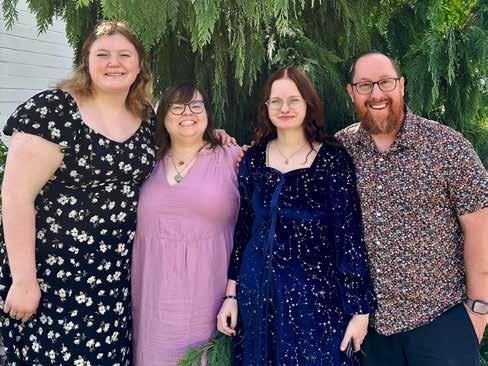
have people to talk to, people who have their best interests,” Davis said. “It gives them the confidence to try things and know there’s a safety net. Life’s a little harder if you have no safety net to try new things.”
Raise the Future serves hundreds of youth, providing families with resources and education, but the waiting list is growing. Kaeding said about 200 youth age out of the foster care system each year in Utah and the organization is doing its best to reach as many of those kids as possible.
There are several ways to help, including volunteer opportunities for longterm mentors, donating school supplies and
providing Christmas gifts for kids in foster care. The option to become adoptive parents is always on the table and Raise the Future creates communities for these families, giving them the support they need for success. For more information, visit Raisethefuture.org.
“It only takes one person to show up for you in your life, to absolutely change the direction that you’re going,” Kaeding said. “If we all rallied together, we could prevent so many kids from aging out of the foster care system. Not only that, we can end that cycle and create healthy people and healthy communities.” l
The Midvale City Journal is a monthly publication distributed directly to residents via the USPS as well as locations throughout Midvale. For information about distribution please email hello@thecityjournals.com or call our offices. Rack locations are also available on our website.
The views and opinions expressed in display advertisements do not necessarily reflect or represent the views and opinions held by Loyal Perch Media or the City Journals. This publication may not be reproduced in whole or in part without the express written consent of the owner. © 2019 Loyal Perch Media, Inc.
PUBLISHER
Bryan Scott | bryan.s@thecityjournals.com
EDITOR
Travis Barton | travis.b@thecityjournals.com
ADVERTISING EXECUTIVES
Mieka Sawatzki | mieka.s@thecityjournals.com
Lindsay Andreasen | lindsay.a@thecityjournals.com
Jason Corbridge | jason.c@thecityjournals.com
Ryan Casper | ryan.c@thecityjournals.com
Marc Davis | marc.d@thecityjournals.com
Rice | lydia.r@thecityjournals.com
Anna Pro Ty Gorton Stacey LaMont

(From left) Ellie, Shawn Davis, Ramona and Matt Affolter have built a family thanks to Raise the Future. The nonprofit helps youth in foster care find permanent homes before they age out of the system. (Photo courtesy of Shawn Davis)

Salt Lake County
801-840-4000
801-799-3000


DATES FOR LEGAL DISCHARGE
*If you live in a restricted area, it is illegal to discharge fireworks anytime
TIMES
*On July 4 & July 24 time of discharge is extended to 12:00 midnight




No student should go hungry: One parent’s mission to end statewide school lunch debt complements new state law
Teen donates portion of college fund to help local elementary students eat lunch debt-free.
By Julie Slama j.slama@mycityjournals.com
Starting July 1, about 40,000 students in Utah will receive free school meals, thanks to House Bill 100, the Food Security Amendments. This legislation eliminates reduced-price lunches, making them fully free for students who previously qualified for the reduced rate.
Sponsored by state Rep. Tyler Clancy, the new legislation aims to address food insecurity and promote share tables to reduce food waste. It guarantees free school lunches for eligible students — from kindergarten through 12th grade — at any school participating in the National School Lunch Program.
Darrell “DJ” Bracken, a West Jordan parent and community advocate, believes the new law also will help tackle Utah’s growing school lunch debt, which reached $2.8 million last year.
“I was just down at the capitol yesterday when Gov. (Spencer) Cox signed the bill,” he said. “I was a part of the coalition along with The Policy Project and Utahns Against Hunger; we advocated for it for about eight months. I think it was very hard for legislators to directly reject the idea of feeding kids at school. I think it’s something everybody can get behind.”
Bracken was shocked when he first learned the extent of lunch debt in his local school district.
“I thought that was impossible. I called Jordan School District and they confirmed to me not only is that number true, but there’s $88,000 in debt in elementary schools alone within my district. I was just completely blown away,” he said.
Motivated to act, Bracken began by paying off Bluffdale Elementary’s $835 lunch debt himself. That experience led him to start the Utah Lunch Debt Relief Foundation to ensure no child in Utah schools goes hungry or accumulates meal debt.
“I thought other people would be just as upset as I am that this exists — and I was right,” Bracken said.
His foundation is designed as a temporary solution to a systemic problem.
“I didn’t want to fill a role I personally felt the government should already be filling so it’s in our charter we will exist until we have gone one full calendar year without any school lunch debt in the state of Utah. This bill is a great solution. It does many great things, taking the group of kids who are getting reduced lunch into getting free lunch. But there’s still going to be lunch debt. I view this as kind of a steppingstone toward healthy school meals
for all; that has been passed in a lot of other states. I would like to see that passed in Utah,” he said.
Bracken’s efforts gained momentum after a single Facebook post in July 2024.
“That got a lot more response than I expected, and we’ve been paying off schools ever since,” he said.
By mid-April, UTLDR had raised more than $51,000. The foundation has cleared meal debt at several schools: Bluffdale, Oakcrest and Aspen elementaries in Jordan School District; South Kearns Elementary in Granite School District; Liberty Elementary in Murray School District; Butler, Quail Hollow and Sandy elementaries in Canyons School District; and more schools in Davis, Provo, Carbon and Duchesne school districts.
Bracken’s goal is to pay off meal debt at an elementary school in every district statewide.
“We’re well on our way to doing that,” he said. “It’s mostly individual people finding our website and deciding to donate on their own, but we have had a couple partnerships with businesses. It’s really been an amazing thing to see how many people care about this.”
Some donations come from individuals moved by the cause. One is 17-year-old David “Van” Hafner, who contributed $2,500 toward paying Butler Elementary’s $6,050 lunch debt. Lunches in Canyons School District cost $3.
“I had my own college saving fund and I dipped into that, plus savings from my many summer jobs and money I saved from the stock market,” he said. “I had a lot of money saved up different ways, so I pulled it all together. I like the idea of doing philanthropy, and I thought this was perfect.”
The Alta High junior also volunteers at a West Valley City daycare and plans to join a humanitarian trip this summer. He was honored with the Smith’s Zero Hunger Award and intends to continue helping schools.
“It’s important I’m doing this because kids at a young age need to learn to help the community, to help other people. I wanted to make an example of that by giving my money to kids who can’t pay for their own lunch. The main concern is kids eat, especially a growing little kid,” said the student who hopes to become a doctor.
His generosity left a lasting impression at the Cottonwood Heights elementary.
“The people at the front desk were very thankful and the kids were excited. They said, ‘That’s a lot of money,’ and ‘That’s really cool.’ It made me feel great. That’s why I want to donate to another elementary school,” Hafner said. “Between this and the West Valley City daycare, it feels like I’m making a difference.”
Butler Principal Tracy Stacy said she was both surprised and grateful for the donation.
Another community member contribut-
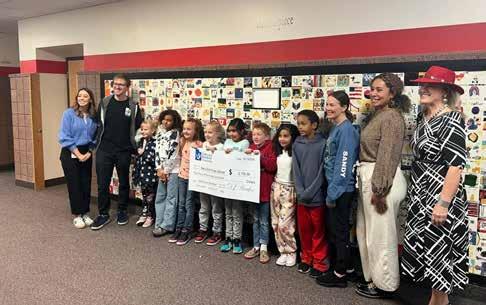
ed; she encouraged her gym members to get involved and raised money to help pay off Sandy Elementary’s lunch debt, Bracken said.
At Aspen Elementary in South Jordan, Bracken’s foundation donated $2,100. However, debt stemming from $2 per lunch continues to be a recurring issue, said Principal Suzie Williams.
“We’re grateful for the donation, absolutely, and we’ve used it, but we don’t want it to be a crutch for people either,” Williams said. “We want to help them navigate how to pay or qualify for lunches. When he came, he tried to reach out to a bunch of families and educate them about filling out forms for free and reduced lunch and that helps, too.”
She noted despite the efforts, debt remains a challenge.
“His donation helped, but we got back up to $3,000 deficit (in late March). When you hit $50 in Jordan School District, then it goes to collections. We called several people today and told them that — and it’s awful. Our lunch debt is down now at $1,700 (as of late April); there always is a debt,” Williams said.
At Liberty Elementary where school lunch is $1.90, Principal Shana Mondragon echoed similar concerns.
“We are consistently in the negative. We’re constantly reaching out to families asking, ‘Do you need help? Have you applied for free and reduced lunch? Do you qualify?’” she said. “I think families are struggling. The responses I get when I call range everywhere from ‘I totally forgot to pay’ to they don’t know how to fill out the form, or didn’t know there was a form. There’s also everybody ate lunch for free during COVID so the assumption is it’s still going. I do appreciate in Murray, regardless of what their balance is, students have the option to get a full lunch every day. It doesn’t fix the budget side of it, but the
kids will always get a full meal. Murray District’s top concern is that the kids eat. We’ll figure everything else out later, but we need to make sure the kids have food. “
Mondragon praised Bracken’s dedication to helping families and spreading awareness. “DJ was helping to educate the families, making sure they had access to the information. He really wants to fix the problem. It isn’t a new problem. If anything, it just keeps getting worse. So, making sure there’s funds, making sure there’s accessibility to the resources and knowing what to do is important,” she said, adding Bracken was honored for his $560 donation to pay off the lunch debt as well as his contribution toward fixing the issue during a “hidden hero” school assembly. “The banner for his foundation is on our website and on our fence to recognize what he did.”
Bracken said the foundation continues to expand its outreach.
“There are many great causes in the world. I have a 7-year-old daughter so this was easy for me to picture a world where there’s some kid out there who’s worried about getting school lunch, and how are you supposed to learn if you’re worried about being in debt instead of focusing on things like fractions?” Bracken said. “It struck me as a failure of the system. These are kids who are accruing debt for the right to eat at a place they have to be —– and we all want them to learn. We all want them to succeed. I was just completely aghast this could even exist, and it turns out most people are too. I couldn’t stand for it. Someone had to do something; I’m glad it’s made an impact so far. Hopefully we can make the full impact and make it so no kid ever has to worry about where they’re getting their lunch again.”
To support or learn more about the Utah Lunch Debt Relief Foundation, visit utldr.org. l
Alta High junior David “Van” Hafner, seen here with Butler Elementary students, contributed $2,500 toward paying the school’s $6,050 lunch debt. (Photo courtesy of DJ Bracken)
Local nursing programs graduate thousands of Utah residents
Nursing education is anticipated to grow by at least 8% in the next 10 years. Utah’s local nursing programs are ready to help students move into the backbone of the healthcare industry.
By Cassie Goff c.goff@mycityjournals.com
ThroughoutMay, graduating nursing students have been walking across stages at their graduation and pinning ceremonies. Thousands of new nurses will begin and/or continue their careers in health care in summer 2025.
“Nurses make up the largest single group of healthcare professionals in the nation and are increasingly taking on more responsibility in healthcare up to and including taking on the role of primary patient care at doctoral levels,” said Bridgerland Technical College Practical Nursing Director Eric Haskell.
“The growth of nursing programs in Utah has been widely recognized as a proactive and necessary response to the state’s ongoing nursing shortage,” said Communications Director at Mountainland Technical College Maile Richardson. “Institutions across the state, including MTECH, have expanded their programs to meet the increasing demand for qualified nurses.”
In Utah, there are over 27 different nursing programs available through post-secondary education institutions for aspiring students to choose from. Students may apply to different programs depending on their options for their hybrid flexible schedules, smaller class sizes, networking opportunities and variable tuition rates.
For example, MTECH’s nursing program (new location in Provo) focuses on hands-on training with industry experts, lab simulations and clinical sites. While Roseman University of Health Sciences College of Nursing program (South Jordan) offers specialty and leadership roles during twoand four-year programs.
“Many of our LPN (Licensed Practical Nurse) students are returning to school after a significant break, balancing education with parenting, work or caregiving responsibilities. This life experience gives them maturity, resilience and a strong sense of purpose,” Richardson said. “Students learn relevant and industry-standard best practices from current nurses.”
Some of these local nursing programs even partner with one another. For example, the two technical colleges mentioned above partner with local universities to help nursing students continue through their education and career goals.
Bridgerland Technical College partners with Weber State University to guarantee BTECH’s graduates a spot in Weber State’s

“Bridgerland Technical College graduates are highly coveted in our local market. Most end up working at one of two local hospitals, local skilled nursing facilities or clinics and a few seek and gain employment at large trauma centers such as Primary Children’s or St. Marks,” said Practical Nursing Director Eric Haskell. (Eric Haskell/Bridgerland Technical College)
Registered Nurse program.
“We share space in our building with Weber State so (students) would attend all of those classes here at BTECH,” Haskell said.
A similar partnership agreement exists between MTECH and Utah Valley University, as students can move directly into UVU’s RN (Registered Nurse) program.
“All of our most recent LPN graduates plan to go to UVU in the fall,” Richardson said. “Students are excited about this transfer credit opportunity and have found it very valuable.”
The majority of students attending the nursing programs listed above are Utah residents. BTECH currently has 96 nursing students per year primarily local to northern Utah, most from Box Elder and Cache County. While MTECH does draw some nursing students from out of state. Last year, 2,093 students graduated from Western Governors University’s nursing programs during their 100th commencement class.
“The goal of nursing…is a science and an art. The science is obtaining research-based nursing knowledge, judgement and skills. The art is the establishment of a caring relationship through which nurses apply nursing knowledge, skills and judgement in a compassionate manner,” said Roseman University’s Director of Marketing Rachel Thomas.
For readers who may be considering nursing school in the future, a few recommendations were offered. Richardson recommended taking the prerequisites of anatomy and physiology beforehand. Haskell echoed that sentiment with the addition of medical terminology and psychology cours-
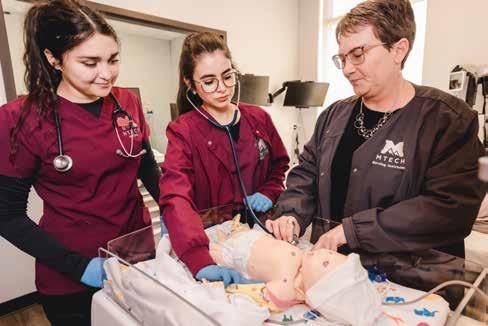
“Once students are in the program, students can expect hands-on, engaged learning. During their time in the program, students will experience classroom-style lessons, hands-on lab simulations, and have opportunities to work in clinical sites.” (Maile Richardson/Mountainland Technical College)

Bridgerland Technical College has been recognized regionally and nationally for their outcomes, affordability and resources. (Eric Haskell/Bridgerland Technical College)
es too. Some of the local nursing programs look for students to have already obtained their Certified Nursing Assistant (CNA) license.
“When nursing school starts, you’ll have plenty of work and studying that you'll need to do,” wrote nursing student Molly Jae Cox through the Nursing Programs Facebook group. “You need a stethoscope and a pen light, and they’ll give you scrub specifications as well.”
Beyond the nursing programs listed above, Utah offers nursing programs through (listed from least-expensive to most-expensive on average tuition costs): Davis Applied Technology College, Night-
ingale College, Uintah Basin Applied Technology College, Utah Tech University, Galen College of Nursing (Draper), Salt Lake Community College, Snow College, Utah State University, Brigham Young University, Southern Utah University, Joyce University of Nursing & Health Sciences and Westminster College.
“Nursing education programs generate more than $8.5 billion in annual revenue, representing nearly 3% of all higher education revenue,” said Alyssa Reynolds, public relations associate for Validated Insights Market Research. “By 2030, the nursing education market is projected to be worth $14.6 billion.” l
Midvale Youth Council engages teens in leadership and service
These high school students stepped up to serve Midvale City.
By Peri Kinder peri.k@thecityjournals.com
Midvale has a team of young leaders dedicated to the community, focused on bringing positive change. The 2024-25 Midvale Youth Council just wrapped up its term of service and reported to the Midvale City Council, detailing some of the students’ projects.
The youth council, made up of high school students, spent the school year working with city leaders to learn about local government, leadership and civic engagement. Their ideas could help shape the city’s future.
“We have a diverse group of students, where we have seniors, we have freshmen, we have kids that are very well-versed with debate and theater,” said Vanessa Guevara, Midvale Youth Council coordinator. “And then you have kids that this is the one item they can participate in. So you get to see this big range of different skills and assets.”
Over the last year, the youth leaders planned several service projects in the city, including making thank-you cards for older adults at Salt Lake County Aging Services, creating street outreach packages for The Road Home that included socks, hand warmers and granola bars, and preparing for a legislative leadership event at the Utah State Capitol.
Led by the Utah League of Cities and Towns, Local Officials Day at the Legislature offered youth councils the opportunity to tour the Capitol, learn about the legislative college internship program, engage in advocacy and get a glimpse of how the legislative process works.
Part of the event included a mock debate, during which youth council members could submit a policy proposal for consideration. The theme was centered on how Utah could prepare for the 2034 Winter Olympic Games. The Midvale Youth Council won both presentations, which focused on Zero Waste Utah 2034. The presentations showcased innovative ideas for a more sustainable future. Youth councilmember Vitalia Sun shared the presentation with the Midvale City Council.
“[Utah] is ranked 26th in the nation for recycling, for common containers and packages, and that number drops to 31st for excluded carbon,” Vitalia said. “[Utah] is still struggling so crucially in this regard and that’s where Zero Waste Utah 2034 comes in. Through private and public partnerships, we have a short-term goal of increasing our recycling rates by the 2034 Olympic Games, as well as a long-term goal of becoming one of the top 10 states for recycling by 2044.”
Other youth council members shared
It’s a fun opportunity to get involved with government, and it’s a great way to discover your own passions, because it’s so diverse
Vitalia Sun
their experience serving the city over the last year and talked about their dedication to ongoing service in the community. Guevara hopes other high school students will apply to serve on the council for the 2025-26 school year. The application will be available at Midvale.utah.gov in September.
“It’s a fun opportunity to get involved with government, and it’s a great way to discover your own passions, because it’s so diverse,” she said. “The main theme is probably community and operations, so you will learn about fields closely related to those two items. You get to have recommendation letters and network and do some of those early exposure pieces that are imperative to your career.”
Before the youth council’s presentation to the Midvale City Council, Mayor Dustin Gettel and the city councilmembers issued a proclamation to honor the life of Elijah Bustamante-Martinez. The Hillcrest High student served as a member of the youth council and was killed in a car crash on March 22.
Part of the proclamation read, “Elijah was known for his unwavering kindness, compassion and dedication to his family, friends and community…He demonstrated exceptional leadership and commitment through his involvement in various community initiatives, including serving on Midvale City’s NextGen Initiative, where he played a pivotal role in community-building efforts and policy advocacy.”
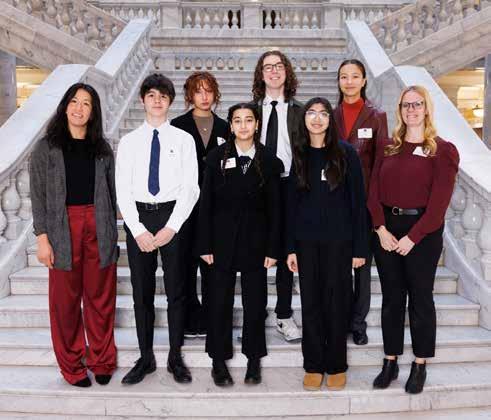
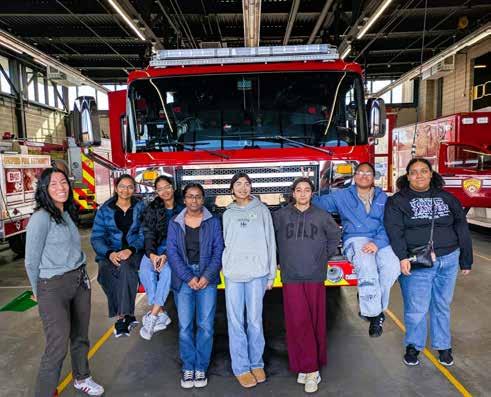
Along with Vitalia and Elijah, the following students served on the 2024-25 Midvale Youth Council: Jonathan Arulanandam, Lina Avila Salinas, Pamela Avila Salinas, Parthiv Balaji, Atticus Bradley, Benny Bridge, Samhita Chavakula, Andrea Contreras, Zander Frisbey, Rita Ishimura, Aditya Jonnalagedda, Aadit Kapadia, Harvin Kushan, Kai McMullin, Shaiyaan Nadeem, Arnav Nair, Noor Naji, Laila Quiroz, Harith Sathish, Narayani Shankar, Kevin Siju
“I feel like every meeting taught me something new, and I’m truly grateful for all the opportunities I was given,” said Zaira. “My favorite part was going to
different city buildings, for example, the police station and fire station, and touring them and talking to the people that work there. Each place we toured gave me a whole new perspective on the work that goes into keeping the city running.” l
Eappen, Ishanth Reddy Sooram, Zaira Syed, Emily Yi, Keerthana Perla and Keerti Perla.
The Midvale Youth Council visited the Utah State Capitol to participate in the Utah League of Cities and Towns Local Officials Day at the Legislature, where they won the mock debate. (Photo courtesy of Midvale)
Midvale Youth Councilmembers toured local government services, including Unified Fire Authority stations. (Photo courtesy of Midvale))
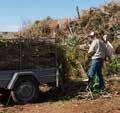
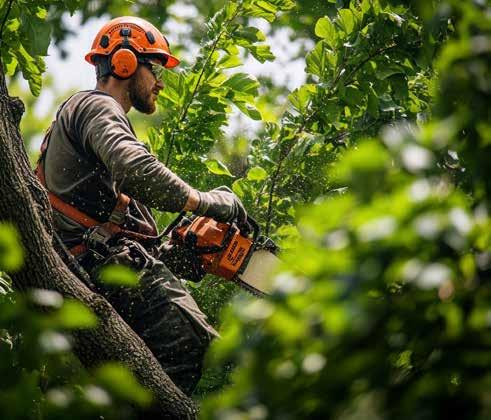






Huskies step up to the plate—for literacy and leadership
Hillcrest baseball players read to elementary students.
By Julie Slama j.slama@mycityjournals.com
Inbaseball, every inning tells a story. But in late April, the Hillcrest High Huskies weren’t swinging bats—they were turning pages, sharing stories and learning that heroes aren’t just made on the field.
“It was a really cool thing we did when we went to the elementary school in our community and read to kindergartners and first graders,” head coach Trevor Thornton said. “I really want our team to give service to our community and help these kids, make it more than baseball.”
He hopes this becomes an annual tradition and the team can expand its outreach next year by giving back to the community in other ways as well.
Now in his second year as head coach, Thornton is focused not only on helping his players improve on the field, but also on shaping the culture and future of the program.
“As far as making the playoffs, we didn’t achieve our goal where we wanted to be, but as far as development of the program, we are going in a positive direction,” he said.
This season, the Huskies had a mix of experience and youth, with seven seniors on the roster alongside two juniors, one sophomore and several freshmen, who stepped into key roles.
“We put some freshmen in those positions because we felt like long term, it’ll help our program and it’s cool we’re getting student-athletes who are good enough as freshmen to play at this level and now they are continuing to progress,”
he said.
Looking to the future, Thornton is launching a summer development program that includes incoming eighth graders. The goal is to get future Hillcrest players experience and exposure before they reach high school.
“We’re going to have a program, which will include incoming eighth graders; our goal is to have them start playing baseball this summer with us. We’re going to invite eighth graders to come participate in our summer games and see where they’re at and try and develop them before spring season,” he said.
The summer schedule, still being finalized, will include games against teams from around Salt Lake and Utah county.
“Our goal is to get our kids between 10 to 14 games this summer, just get them playing, getting more reps, continuing their development,” Thornton said.
To further build the program, he also plans to host a skills camp for fifththrough eighth-grade players in late January or early February. Current team members will help mentor younger players during the camp.
The goal, Thornton said, is to build not just talent, but a strong start for the 2026 season.
This year started strong for the Huskies, with early promise shown during a preseason trip to Hurricane, where they played tough competition from out of state.
“At the beginning of the year, we had players who were playing a step above where we thought they would, which was super awesome to see. We went to Hurricane and met up with Centennial, a good school out of Boise. We were in the game right into the seventh inning, it was 4 to
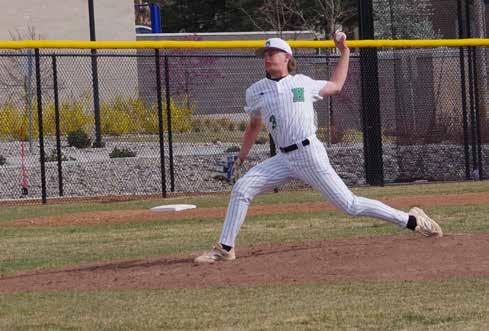
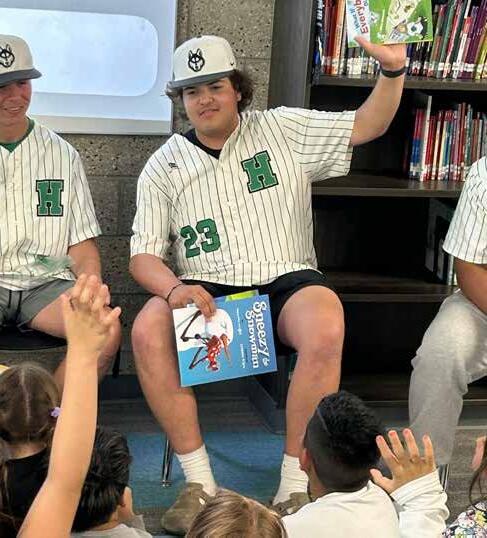
4; we ended up losing it 6 to 4. We were good early in the year and put up a couple wins,” he said.
But injuries soon took a toll.
“We had an injury plague and lost a couple kids for the season, including our starting center fielder,” Thornton said. “That was hard because he is one of those kids who ignites the whole team, so it kind of deflated some things.”
Still, Thornton saw encouraging signs as players stepped up and competition within the team pushed everyone to improve.
“As the year was progressing, there was a lot of competition on the team, which helps our older kids stay motivated and helps our younger kids battle. It helps the culture inside the program,” he said. “Some of those players were able to step into those roles and progress, even though we’re not winning all these games.”
Thornton was especially proud of the mindset among the younger players.
“One of the big things I appreciate about our younger kids is they have the mentality of, ‘I am here to get better, but it’s not just me. It’s not about me, it’s about the team, and what can I do to help
everybody around me be better,’” he said. Thornton also credits the senior class for their leadership and mentorship.
“Our seniors are helping our young kids get better. They are wanting to help those younger players get better because they know they’ll take their spots. The mentality is ‘We have one group, and we all get better, it helps grow the program,’” Thornton said. “At the same time, seniors ask, ‘What am I going to do after baseball is over?’ We’re helping develop this leadership mentality to become a better person post high school.”
While no seniors from the 2025 class have committed to playing at the next level yet, two recent graduates from 2024 are continuing their baseball careers—Matt Miller at the College of Idaho and Cooper Limb at Colorado Northwestern Community College.
Looking ahead, Hillcrest will be moving up to 5A from 4A region 10.
“We’re looking forward to playing next year in a new region,” Thornton said. “It’s new faces, new opportunities to challenge ourselves to become better and see how good we are—that’s our goal.” l
Hillcrest freshman Boston Carrell fires one to the plate during the April 11 game against Tooele High.
(Julie Slama/City Journals)
Hillcrest senior Alex Lopez traded in his bat for a book to read to Midvalley Elementary students. (Photo courtesy of Gary Tomlinson)



MIDVALE CITY DIRECTORY
City Hall
801-567-7200
Finance/Utilities 801-567-7200
Court 801-567-7265
City Attorney’s O ce ......................... 801-567-7250
City Recorder/Human Resources ... 801-567-7228
Community Development ............... 801-567-7211
Public Works 801-567-7235
Ace Disposal/Recycling 801-363-9995
Midvale Historical Museum 801-567-7285
Midvale Senior Center 385-468-3350
SL County Animal Services 385-468-7387 Communications 801-567-7230
MIDVALE CITY ELECTED OFFICIALS
Mayor - Dustin Gettel
Email: dgettel@midvaleut.gov
CITY COUNCIL
District 1 - Bonnie Billings
Email: bbillings@midvaleut.gov
District 2 - Paul Glover
Email: pglover@midvaleut.gov
District 3 - Heidi Robinson
Email: Hrobinson@midvaleut.gov
District 4 - Bryant Brown
Email: bbrown@midvaleut.gov
District 5 - Denece Mikolash
Email: Dmikolash@midvaleut.gov
WHO TO CALL FOR…
Water Bills
801-567-7200
Ordering A New Trash Can 801-567-7202
Permits 801-567-7213
Court 801-567-7265
Paying For Tra c School 801-567-7202
Business Licensing 801-567-7214
Cemetery 801-567-7235
Planning and Zoning 801-567-7231
Code Enforcement .............................. 801-567-7208
Building inspections ........................... 801-567-7213
Graffiti 385-468-9769
PUBLIC SAFETY & EMERGENCY CONTACTS
EMERGENCY 911
UFA Fire/UPD Police
> Non-emergency .............................. 801-840-4000
Uni ed Police Department
> Midvale Precinct 385-468-9350
Public Works 801-567-7235
Rocky Mountain Power 877-508-5088
In The Middle of Everything
City Hall – 7505 South Holden Street • Midvale, UT 84047

Midvale Monthly with Mayor Gettel
Investing in Midvale’s Future: Budgeting for Continued
As we move forward into a new scal year, I want to take a moment to share some important highlights from the City’s tentative 2025-2026 budget. This year’s proposed budget re ects both our community values and our commitment to providing essential services e ciently and sustainably.
Two of the most signi cant increases in this year’s budget are in public safety and employee wages, and I’d like to share why these investments are not only necessary, but vital to the long-term success of Midvale.
A Safer Midvale for All
Public safety has always been a foundational priority for our city. This year, we’re expecting a 3.8% increase, approximately $520,000, to the Uni ed Police Department (UPD) budget. This investment will help support competitive wages and bene ts for our o cers, enhance access to essential protective equipment, expand critical training opportunities, and ensure we maintain the sta ng levels necessary to respond quickly and e ectively to the needs of our growing community.


Safety is more than a line item: It’s the foundation of a thriving city. When residents feel safe in their homes, businesses, parks, and neighborhoods, they are more engaged, more connected, and more willing to invest in the community. Our public safety personnel work tirelessly to keep Midvale secure, and it’s our responsibility to ensure they have the resources and support they need to do their jobs well.

Investing in Our People
Success
The second major increase in this year’s tentative budget is an investment in our city’s most valuable asset: our employees. From public works crews to community development sta , city employees keep Midvale running every single day.
Our proposed Fiscal Year 2026 budget includes 2.2% cost-of-living and 2% merit increases for all eligible employees. This estimated $230,000 overall increase is not just about staying competitive in a challenging labor market, it’s about recognizing the hard work, dedication, and professionalism of the people who serve the residents of Midvale. Retaining top talent ensures continuity, e ciency, and better service delivery. It means fewer disruptions, faster response times, and a city government that truly understands and responds to the needs of its residents. Competitive wages and bene ts also help us attract highly quali ed candidates for open positions, further strengthening the quality of service you receive.
Balancing Responsibility with Vision


As careful stewards of taxpayer dollars, we balance scal responsibility with the bold, strategic investments needed to build a stronger future. By prioritizing public safety and employee compensation, we are laying the groundwork for a stronger, safer, and more resilient Midvale.
Thank you for your continued trust and engagement. As always, I welcome your thoughts and input as we nalize the budget and continue building a better Midvale together!




In The Middle of Everything
Midvale Harvest Days: 87 Years Strong
In 1938, when the local Kiwanis Club announced the rst “Harvest Days”, there were only 2,700 people living in Midvale City. Since then, the celebration has held a special place in the hearts of Midvale residents, with memories spanning generations.
Fred Tanner attended those rst Harvest Day celebrations, when the freeway was still railroad tracks kids played on the slag dumps.
“I was really young then,” Tanner re ected. “The leaders would block, with sandbags, both ends of Main Street—from Center Street over to First Avenue. They’d turn on the re hydrant and put sh in there. People don’t believe me, but this is the honest truth.”
Other prizes, like pet ducks, could be won by tossing a nickel into a cup. Tanner won several ducks, but his favorite, Skippy, who was almost dinner. Tanner said, “No, not him.” When he tried to free the duck at the river, the duck wouldn’t have it. Local smelter cop Roy Steadman spot-
ted them walking home and paid Tanner 50 cents to keep Skippy. His life was saved.”
“Harvest Days” lived up to its name in 1942, when local farmers were low on labor and requested schools to send kids out during the day to help them gather the ripe vegetables and fruit.
In the 1950s, Joseph Gomez remembers Midvale hosting the 3rd largest parade in the state. “It was very exciting to see motorcycling policemen, we loved to hear them rumble by,” Gomez reminisced.
He and his friends loved the carnival rides and prizes, too. “Once the parade was over, everyone would head down to the end of Smelter Street to a huge carnival with a Ferris wheel, Octopus and The Hammer,” Gomez said. The kids would rush to get Chinese handcu s and kewpie dolls with feathers and a big head.
Gomez and other kids his age were encouraged to sell tickets for a ra e for a brand new car–Yes, you read that right, this was no Matchbox car prize– a real, working car. Tickets sold for a single dollar, and the kids would get 10 cents for every ticket they sold.
Midvale Explore
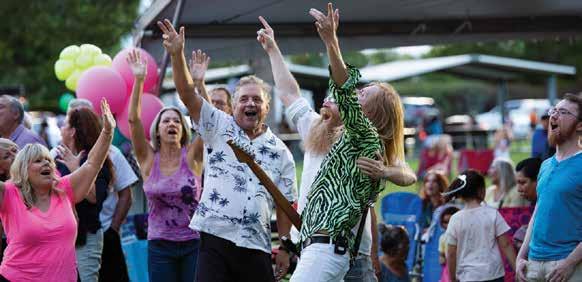




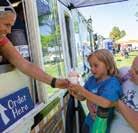

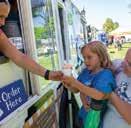

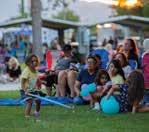




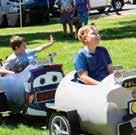







In 1955, Harvest Days featured daredevils like The Great Kisselburg who crashed through rewalls in a car, juggling acts, and wrestling matches with names like Man Mountain Dean Jr. and Roughhouse Spud Harris.
In 1970, Harvest Days boasted the world’s championship watermelon seed-spitting contest.
“Angels Camp, Calaveras County, Calif., may have their frog jumping contest but Midvale, taking a back seat to no one, will stage the ‘World’s championship watermelon seed spitting contest’,” The Midvale Sentinel exclaimed.
This was also the year for good shopping deals. “Midvale merchants conduct[ed] one of the largest sales of merchandise in the history of the town,” said The Midvale Sentinel.
In 1992, a booth at the carnival o ered ra e tickets for a handmade quilt. This wasn’t an ordinary fundraiser– The proceeds were going to the family of 14-year-old Jennifer Ortega, who needed a live-saving liver transplant and they needed help covering the $250,000 procedure in San Francisco.
Former Mayor Robert Hale recalls quirky highlights, like goat yoga. His favorite activity was the block parties. “They really bring neighborhoods together,” Hale remembered. “it made neighborhoods responsible for what’s happening. City o cials and police would come and people would work out neighborhood issues.”
The Midvale Museum sees more visitors during Harvest Days. In 2024, Director Bill Miller brought in paranormal investigators. “The uniform over there,” he said, pointing to a military display, “mentioned my name a few times.”
The train shows ended after Marty, who ran them, passed away—but Miller still senses him. “Sometimes I feel like Marty’s still here,” he said. “I think I’m the last person that ever talked to Marty.”
When Candy Tippetts was in charge of Harvest days for six years, she organized events like Bingo, movie nights, and safety night with free helmets. The biggest attraction was Bingo. “The park was packed for Bingo,” Tippetts mused. “There were free prizes. We would usually have something big like a big-screen TV.”




“Our reworks are the best show in the valley,” Tippetts proudly shared. “Harvest Days is the last city event in the summer – We’d get a really good deal on reworks because [sellers] can’t store them.”
Some things change and some things stay the same. The Queen contest became the Youth Ambassadors program, which eventually grew into the Mayor’s NexGen initiative. While we no longer ood Main Street or ra e o brand-new cars, we host Art Shows and Museum nights. We still have bingo, carnival row games and, of course, reworks!



What continues is the heart of the celebration: neighbors connecting, families making memories, and a city coming together to laugh, play, and celebrate where they live. Whether it’s catching trout, winning a atscreen TV, or watching reworks light up the summer sky—Harvest Days is, and always will be, about community. And 2025 will be no di
– We can’t wait to see you there!
JUNE 2025 CITY NEWSLETTER
MIDVALE. UTAH. GOV
Meet the Midvale Main Art House Artists: Ash Amos
For Ash Amos, art isn’t simply a career choice – it’s a way of being. His professional journey

As he entered adulthood, art became a deeply personal outlet for processing grief. “I lost one of my best friends who was in one of my bands,” Amos re ected. “In that dark time, I found a bunch of my grandma’s paintings. I just helped myself to them. I started painting as a way to deal with those extreme and heavy emotions, and to escape.”
Though paint is his most practiced and familiar medium, he has branched out to include typography, digital art, large-scale installations, sculptures and woodworking. His guiding motto for remaining versatile and growth-minded: ‘A jack of all trades but master of none, but oftentimes better than the master of one.’
The Midvale Main Art House is a creative cornerstone of the community—an incubator for artists and a hub for cultural connection. Situated along a stretch of Main Street adorned with over 40 murals, it plays a key role in the area’s transformation into a recognized Arts and Culture District. The space o ers hands-on workshops, fosters relationships between residents and local artists, and showcases distinctive, oneof-a-kind artisan creations.
Amos has been at the Midvale Main Art House since it opened in 2024 where he has been perfecting the basics and falling in love
“When I rst started, I wanted every painting to be packed with symbolism and a message with peace or tranquility,” he recalled. “As I’ve gone on, I’m more focused on developing techniques without relying too much on a message. If you can make your artwork just using just the most foundational elements of design–art, shape–and create something that’s striking and beautiful–that’s what endlessly fascinates me.”
An art career is not for the faint of heart. “Last year was the rst time my income wouldn’t be considered extreme poverty,” Amos said. But to rise up as an artist is not a solo endeavor. He believes in the power of community. Other artists aren’t competition; He believes that “rising tides lift all boats.”
Art from one artist will speak to people in di erent ways, making all art valuable. He believes in symbiotic relationships where artists help each other succeed.
Amos envisions his future with a dedicated space that combines a retail area, workshop, and production facility, equipped with the tools necessary for large-scale art creation and printing. This space would serve as a creative incubator, allowing for the development of immersive installations and fostering a collaborative environment for artists.
To nd that future, he nds that he needs to be adaptable.“If I work hard and have integrity, and am passionate, things are going to work,” he said. “Hard things are going to work out, one way or another.”
Sharing his work with the world isn’t about courage; it’s about staying true to who he is. Art is not only his calling, but the language through which he processes life, connects with others, and builds community. “I can’t imagine not doing that,” Amos mused.
The Midvale Main Art House, located at 7697 S Main St., is open to the public. You can meet the artists, like Ash Amos, join interactive workshops, purchase one-of-a-kind art and explore an open gallery showcasing local art.
Hours of operation: Tuesday - Thursday: 5pm-8pm Saturday: 2pm-7pm
Learn more at EngageMidvale.com/Art-House.


From Retail to Roo ops: e West Main Project Takes Shape
Progress continues on Main Street— The Pearl Theatre got a face-lift, new lights illuminate the street, murals bloom across the buildings, and a fresh wave of restaurants and shops are emerging.
On the northwest side of Main Street, between Smelter St. and Depot St., a new project is underway, with completion scheduled for Fall 2025. This area, like the rest of Main Street, is multipurpose. The ground oor will be retail and restaurant, while the upper oors will be a ordable housing.
And when we say a ordable, we mean it. The residents who can live here need to be under the 60% AMI for the area–in other words, they need to make 40% less than the median income of the area. A ordable here does not mean primitive. The living space includes a rooftop patio with BBQ areas and a dog run. There is exclusive parking for residents, a gym, and easy access to the shops on the ground oor, as well as direct access to Main Street.
The West Main Project helps bring to life the entire street, especially on the north end that has fewer attractions. “This one checks so many boxes,” Nate Rockwood, Assistant City Manager and long-time project contributor, said. “Retail, restaurant, a ordable housing, amenities on the rooftop. These are things that will actually activate the street.”
Main Street continues to ourish under the watchful eye of Midvale’s RDA, with the annual Los Muros Mural Festival, improvements outside The Pearl, and the opening of the food truck plaza this summer. Stay tuned for more news on the rejuvenation of Main Street, Midvale!
Protect Your Pet from Summer Fun
Salt Lake County Animal Services
More pets go missing in the summer months than at any other time of year. Make sure they always have on a collar with an ID tag, with up-to-date info. Microchipping your pet is also important in the event your pet goes missing.
Watch out for these sounds of summer:

Barbecues: If guests are going to be coming in and out of the front door or back gate, keep your pets in a secure area, or put them in their crate. An unsecured gate or door left open is the perfect opportunity for your pet to take themselves on an adventure without you.
Thunderstorms: According to the ASPCA, 1 in 5 pets goes missing after being scared by loud noises. Be sure to bring your pet indoors and keep them away from open windows when summer storms roll into your area.
Fireworks: The loud noise of rework displays, big or small, is scary and disorienting to pets. Leave them at home, inside with a loud fan, or calming music. If the reworks display is in your driveway, be sure to clean up the leftover rework debris, never underestimate what your dog may try to eat. Fireworks are poisonous to pets.
All pets in Salt Lake County can receive a free microchip at Salt Lake County Animal Services. We welcome you to bring in your pet to Animal Services at 511 W 3900 S, Tue – Sat, 10 AM -6 PM, to get your pet microchipped.
Find a lost pet? Contact your local animal control! The rst place pet owners look for a lost pet is at their local shelter. How you can help if you nd a lost pet: post a photo of them, where you found them, and what shelter they went to on the NextDoor App or Utah Lost & Found Pets Facebook Group. All pets at Salt Lake County Animal Services can be seen online at AdoptUtahPets.org.
Community Heroes: High school choir director left lasting impression on thousands of students
Kerry Moore cared about his students beyond the classroom.
By Becky Ginos b.ginos@mycityjournals.com
Mostkids don’t remember their high school teachers let alone keep in touch for years after graduation but it’s different with Kerry Moore’s students. The Bountiful man was the choral music director and German teacher at Cyprus High School for 35 years and left such a lasting impact that former students still called him “friend.” Moore passed away April 16 after a lengthy battle with pancreatic cancer.
“He was an amazing teacher and so much more,” said Brent Graham, who graduated in 1998. “He was the person I needed at the time. He was the closest thing to a father.”
Graham grew up without a father and his mother passed away after he graduated. “It left a big hole,” he said. “I was a scared little 19 year old. They (Moore and his wife Stacey) basically took me in. They’d invite me to Sunday dinner and Christmas. Otherwise I would have been alone.”
He loved teaching, said Graham. “It wasn’t a job, it was like a calling. He made you want to be a better person. His joy was infectious.”
“He was that guy,” said Blake Halladay who graduated in 1997. “You knew he cared beyond class. Many times I’d talk to him after school for hours. If kids had personal problems at home he’d step in to help. He was there for that.”
Kerry and Stacey were a power couple, Halladay said. “They could have done so much but they chose to teach high school. That says volumes about their character.”
Once kids graduated it didn’t end, he said. “My wife and I would go places with them. There are three men who changed the trajectory of my life. My father, my father-in-law and Kerry.”
Halladay spent time with Moore a few days before his passing. “I told him ‘I’m a better man because of you.’ He said, ‘Me too.’ That really hit me to think he feels blessed by me.”
“The most interesting thing about him was the passion and love he’d put into every project,” said Liz Oates who graduated in 1997. “You never felt like an afterthought. He wanted us to succeed. He would push us but we always felt that love.”
Oates said Moore was close friends with her father. “He and my dad were such good comrades. My dad wrote some music and when he died unexpectedly from a heart attack Kerry played dad’s album at his funeral. It was so touching. He was busy in his life but it was so special that he took the time to do that.”
Her senior year, Oates said one of her classmates was homeless for a time and living in her car. “He would check in on her and another classmate who had a horrible thing happen to her. He sat down and consoled her. That’s why so many people remember him. If you were down and out he’d be a friend to help people to recover.”
“Kerry was so patient and loving,” said Jeremy Felt who graduated in 2019. “He helped us find success. He would check our grades and see what he could do to help.”
In addition to choir, Moore was involved with the school musicals, Felt said. “I did a lot of musicals with Kerry and his wife who did the choreography. When I was the lead in ‘Pirates of Penzance’ he told me to envision the music. He said music is the universal language to connect with people. He said the words might fade but they would always remember that song—music is so impactful.”
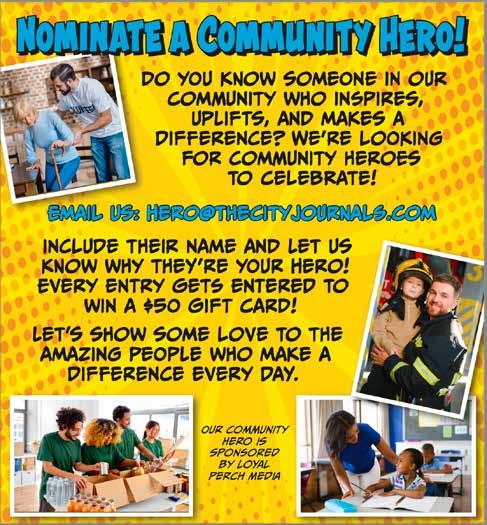
Felt said he also took music theory from Moore. “I still have my binder that he created. I create music for fun now in remembrance of Mr. Moore. I’m involved with community choirs and theater because of Mr. Moore.”
He was like Mr. Rogers, said Felt. “I’m so grateful that I got to be a part of his life. He touched the lives of others. He’s going to be missed.” To submit your Community Hero nomination, emailHeros@TheCityJournals.comll
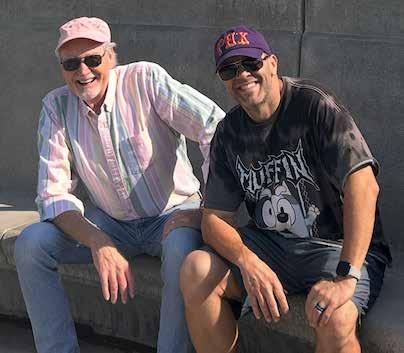
Hillcrest Huskies are state runners-up in unified basketball
By Julie Slama j.slama@mycityjournals.com
In a state finals against Snow Canyon High’s Unified Warriors, Hillcrest High’s coed unified basketball team reached for every loose ball and shot to score at every chance, but Hillcrest came up short.
The Huskies had secured the opportunity to play in the March 28 championship in their division at the Delta Center after advancing from the regional Canyons-Jordan-Murray school districts’ tournament.
Unified basketball embraces students with and without intellectual disabilities to play side by side. The program, supported by both Special Olympics Utah and the Utah High School Activities Association, now boasts more than 200 high school coed unified basketball teams across the state.
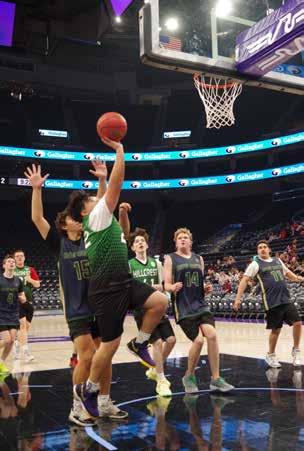
Kerry Moore (left) with former student Brent Graham. The pair continued to be close friends for years after Graham’s graduation. (Photo courtesy of Brent Graham)
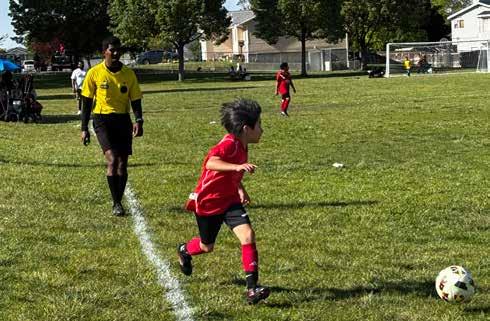
Soccer officials rally for fair pay and improved working conditions
It’s more than just a pay raise as referees ask for respect, acknowledgement too.
By Greg James g.james@mycityjournals.com
Apetition
is circulating in the community in an attempt to raise the pay of soccer officials and improve sportsmanship, which has become an important topic amongst association officials.
“This is more than just a way to ask for a pay raise,” one of the petition organizers Joel Rincon said. “We are asking the UYSA to recognize the invaluable contribution of referees to the game. We play a significant role in maintaining the integrity of the league. It is a call for respect and acknowledgement. We implore the UYSA to raise the wage of referees.”
The Utah Youth Soccer Association is taking the initiative seriously.
“We are discussing the petition with the group of referees who created it,” UYSA Chief Executive Officer Bryan Attridge said. “We have an official meeting scheduled with our state referee committee. We know being a referee is hard, but we were just notified of this petition.”
A close offsides non-call in a youth game was further evidence something needs to be done. The coach stood on the sideline wildly waving his arms and berating the referee. Finally the referee yielded a red card to the coach, grabbed the ball and stood at midfield waiting for the coach to leave the field. The game was eventually forfeited.
“Sportsmanship is becoming a huge problem,” Rincon said in the petition.
The petition includes several comments from past officials and parents. “My son almost quit. We make stressful decisions, Utah is one of the lowest paying states, plz [sic] change for the better,” and “This is a great first job for some teens, but is it worth it,” are among some.
Over 650 people have signed the online petition on change.org. The petition states that referees feel “berated, slighted and improperly enumerated.”
More than two years ago the UYSA adopted a zero tolerance policy toward referee abuse. Any team that has a fan, player or coach that abuses a referee can receive a strict no spectator ruling. The team will not be allowed to have anyone on their sidelines for the entire season.
In March, USA Soccer adopted a similar referee abuse prevention policy, violations could include lifetime bans.
“Soccer is a beautiful game that brings out a passion in its players, coaches and fans. When passion crosses the line it harms the games integrity and the safety of those who work in it. Referees are essential to our game,” USA soccer released in its abuse prevention packet (policy 53-91).
According to Utah State Soccer Referee Program, the current pay scale for the UYSA was adopted in 2022 and ranges between $30 to $65 per game. The USSRP serves soccer associations by increasing the number and quality of officials and achieving excellence among those officials through education and administration.
“It is time for us to stand up for change,” Rincon said. l

Chasing kids around the pitch is more difficult than it seems, but making perfect calls has become nearly impossible. Soccer referees ask youth associations to consider pay increases and sportsmanship improvements. (Greg James/City Journals)
Hillcrest alum completes second Boston Marathon, pursues 50-state goal before turning 50
Mother of six and grandmother of two, is driven by passion and desire to help others in their fitness goals.
By Julie Slama j.slama@mycityjournals.com
A1996 Hillcrest High alumna finished the Boston Marathon for the second time—and already has qualified for her third.
Just two days prior to the 129th running of the Boston Marathon, 47-year-old Karin Nielson Nelson also ran the Newport Rhode Races marathon in Newport, Rhode Island, her 31st state toward her goal of running a marathon in all 50 states before she turns 50. She has run most of those marathons in the past two years.
“One of my favorite things to do on a Saturday is to go for a long run, and that’s how I treat many of them,” Nelson said. “I get a long run in a new state, and I see a beautiful place. I get to know people on the course, and I just have fun. I meet people who I can help pace them to their goals and help them, because I don’t need to win; I don’t care. I do run some fast, but for the most part, I’m running for the enjoyment. Either way, I get a medal.”
The Draper resident displays those medals on a plaque gifted to her by her husband.
“I color in each state on my little chalkboard, and it’s satisfying,” she said, adding she generally only kept her race bibs from Boston.
Nelson’s quest to run all 50 states began recently.
“I did sprints in high school. My body is built for short distance. I have the stronger quads, I have the power muscles,” said the Husky alumna, who graduated with a 3.9 grade-point average and participated in cheer, dance company and several clubs. “I was ‘Little Miss High School.’”
At BYU, Nelson stayed active with dance and occasional running while earning her degree. Inspired by Oprah Winfrey’s marathon story, she signed up for her first race 20 years ago.
“Between my number two and number three child, I read Oprah Winfrey had run a marathon, and I thought if Oprah can do it, so can I,” she said.
Nelson followed a marathon training program online.
“I was so excited when I first hit six miles on the treadmill. I was so proud of myself. I built my mileage up and, on the weekends, I met up with a friend from high school, and we would just run down the canyons, trying to get our quads strong for the race,” she said. “When I ran Top of Utah, everything fell apart. I had stomach

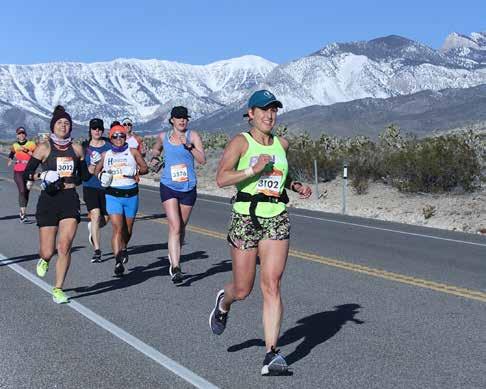
issues, and I lost a toenail. I hated every second of it. I quit running for 15 years; I was never going to do a marathon again.”
Moves to California and then Georgia reignited her training. Nelson entered a local half marathon and placed first in her age group.
“I pushed it and I got first in my age division, and I was like, ‘I’m faster than I thought,’” she said, but also knew “I never was going to make Chicago or New York or any of the bigger races; I wasn’t close. But this one felt good.”
Nelson joined a group of early-morning runners.
“It depended on how long we’d run as to what time we’d start,” she said, adding her sixth child was just 18 months old so often, she’d nap with her after running up to 20 miles before getting her other kids off to school. “Those runners were fast. I ran with them; I didn’t think anything of it. We chatted while running and had a party.”
In November 2019, Nelson attempted to qualify for Boston at the Chickamauga Battlefield Marathon in Georgia.
“I wanted to qualify for Boston. I was shooting for around a 3:35 pace, but I didn’t know how to fuel. I was a rookie. By mile 17, my batteries just ran out. I was completely depleted. My time was a 3:40, just off the qualifying time,” she said.
Still determined to qualify for Boston, Nelson and another runner in the group “trained our butts off. I was in the best running shape of my life, going as fast as I’ve ever run.”
Then, COVID-19 canceled the race. She attempted Boston qualification again at the Surf City Marathon in California,
but illness and high heat thwarted her race pace.
An unexpected entry into the St. George Marathon followed, where Nelson clocked a sub-four-hour finish.
“It was respectable, but it wasn’t at all my goal pace,” she said.
Nelson’s next attempt, at the Mt. Charleston Marathon in Las Vegas, was emotionally charged.
“The day before the race, my mom called to say my dad was in the hospital,” she remembered. “I ran that race, thinking about my dad the whole time and dedicated to him. He passed away a couple days later, but I made it back to see him.”
Nelson finished in 3:38—fast enough to qualify for Boston.
That’s about when she learned about the 50-state challenge.
“I was like, ‘That’s cute. I’ll think about it.’ When I was talking to one of my best friends, she said, ‘You’re 45 you should do all 50 before you turn 50,’” she said.
Nelson turned to a 50-state marathon club on Facebook and was encouraged by others to “totally go for it.”
At that time, she had run marathons in five states, including New York City, and had planned to run Grandma’s Marathon in Duluth, Minnesota. Still undecided, Nelson ran one in North Carolina on Mother’s Day, her third in three months.
“That’s when I became fully committed to 50 by 50,” she said. “I know it’s crazy, but I’ve enjoyed it. I meet the coolest
people; I help pace them to their goals and get to know them.”
Nelson finds it rewarding to pace others.
“I’d rather be a friend to somebody and enjoy the race. I get so much more out of that because who cares if you win all the time? That’s very self-serving. It doesn’t do anything for anybody, plus, it’s not good for my body,” she said.
To help fund races, Nelson has coached fitness classes both in Georgia and Utah.
Through dozens of marathons, she’s honed her strategy.
“Last May, I ran Conway, North Carolina, after running others, and I got a 3:34 so I beat my PR by four minutes. I’ve discovered, I do a lot better if I keep training than take a month off. I bounce from one to the next just giving my legs a little rest the week after a race and the week before a race,” she said.
Despite the demanding schedule, Nelson has remained strong, even placing in the top three at the Marine Corps Marathon in amongst competing in other marathons in several weeks.
“I was just going to go enjoy the day knowing my legs were probably tired, but my legs felt fresh and that’s where I ended up qualifying for Boston again,” she said.
Nelson qualified again the very next week.
“I didn’t expect to even feel as if I had any energy left, but I felt fine. The body is amazing; it can do more than we think
Hillcrest High alumna Karin Nielson Nelson ran her second Boston Marathon this spring and already has qualified for her third. (Photo courtesy of Karin Nelson)
It was at Mount Charleston Marathon in Nevada where Draper resident Karin Nelson first qualified for the Boston Marathon. (Photo courtesy of Karin Nelson)
New tool at Intermountain Hospital aims to tackle allergy season
Data from the spore collector can help doctors treat allergy patients more effectively.
By Peri Kinder peri.k@thecityjournals.com
With spring comes seasonal allergies, causing itchy eyes, runny noses, constant sneezing and the search for relief. Intermountain Riverton Hospital is stepping in with a fresh approach: the Burkard pollen and spore collector.
The device sits on the hospital’s roof where it gathers mold scores and pollen counts. That information is then processed by looking under a microscope to observe and interpret which pollen count is high on any given day. The data will help patients and doctors work to improve the way allergies are triggered and treated.
Dr. Scott Taylor, an allergist at the Intermountain Riverton Southridge Allergy Clinic (3723 W. 12600 South), said while the device isn’t new, it’s the first Burkard collector on the south side of Salt Lake County.
“We got certified as a National Allergy Bureau investigation site, so it’s kind of exciting,” Taylor said. “The Burkard spore collector has been around since the 1950s but it’s improved over the years. It also helps people who have asthma, which can be triggered by pollen, as well.”
Once data is collected, patients can go online to see pollen counts and will have a better idea of how to create specific treatment plans with their allergists. Daily pollen counts are posted at Intermountainhealthcare.org/locations/ southridge-clinic/allergy.
“Patients are noticing every year that they have similar symptoms around the same range of time,” Taylor said. “It’s
it can. But obviously, listen to your own body; don’t hurt yourself,” she said.
In December 2024, a hamstring injury forced Nelson to stop mid-race in a chilly Redondo Beach, Delaware marathon.
“I quit at mile 11, and it broke my heart. I’ve only quit that one marathon, and it still eats at me even though it was the right thing to do,” she said.
After recovering, Nelson resumed her streak, running in Mississippi, Pennsylvania and Rhode Island—where she paced a first-timer and soaked her legs in the Atlantic.
“I held myself back knowing I had two races in three days,” she said. “Afterward , I sat with my legs in the Atlantic and soaked, like a cold plunge,” she said.
At Boston, Nelson started pacing another runner from Utah, but eventually ran her own race.
“I felt strong, which was surprising after just running a marathon two days before,” she said about her 3:49 finish.
Next up: marathons in Montana in May and in Colorado in June; and possibly two per month if costs can be shared.
Running, Nelson said, is essential for her mental health.
“When I run for a certain amount of time and push myself, I get a serotonin surge because my body releases those en-
important to meet with an allergist, to get good testing done and get treatment for their symptoms.”
Taylor said there are about 20 top allergens in the Salt Lake Valley, depending on the time of the year. Tree pollens come out in the spring, grass pollens in the summer and ragweed in the fall. During the winter, allergies tend to come from being inside with pets. The Burkard, or the Big Green, as Taylor called it, is turned off during the colder months.
South Jordan resident Julia Jones has worked with Taylor for the last decade, finding relief for her daughter who suffers from extreme allergy symptoms including the swelling of her ears and eye lining. Jones also developed allergies a few years ago and is careful to create a home environment that fosters clean air.
“It used to be we couldn’t use the swamp cooler in our house, just [air-conditioning] only, which is much more expensive and the windows were shut all the time. There were days when there was no going outside at all,” Jones said. “Now, as allergy shot patients, we can look on the website and see specifically what we’re reacting to on which days. So say I’m having a lot of symptoms, maybe it shows the ash tree is high. Then [the allergist] can take that information and increase the amount of ash in my serum that they’ll use for my allergy shots.”
Jones can also take the daily pollen count and adjust behaviors. For instance, if ragweed counts are high, she’ll wear eyeglasses instead of contacts because she knows her eyes will be itchy and watery all day. She can also take higher doses of antihistamines or talk to her doctor about treatments that bring long-lasting relief.
“It’s not this major trial for most people, but it is annoying. It’s irritating to have these symptoms and when you see
dorphins. I need that high. Running saves me. It’s my therapy. On the days I don’t run, I get a little grumpy. My sweet husband is so good about that and will say, ‘Oh, did you run today? I’ll watch the kids, just go for a run,’” she said.
Nelson encourages people to find what challenges them.
“If it’s a 5K that will push you, then set it as a goal. Find the challenge that fits you. I do a full marathon because it’s hard. If I’m not constantly pushing then I’m not getting any better or stronger or faster. I know I’m getting older, and I should be slowing down, but don’t tell me that,” she said.
After 50 states, Nelson is eyeing a 50mile race.
“I’m thinking I’ll do my 50 by 50 in January, maybe in Hawaii, and then, look for a 50-miler in March for my birthday,” she said.
Nelson won’t stop once she finishes that finish line.
“I’m doing Australia this summer, one of the Abbott World (Marathon) Majors. I’ve already done Boston, Chicago and New York so I need London, Berlin and Tokyo. Sydney is being added to that,” she said. “My goal was 50 by 50, but now it includes the big six by 60 and all seven continents by 70.” l
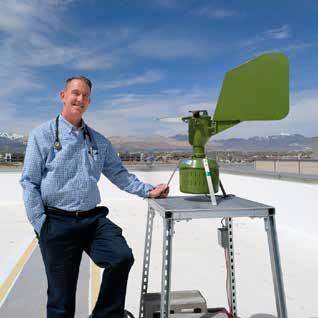
the blossoms on the trees, you know symptoms are coming,” she said. “It’s a blessing to have tools like this device that we can check online and that we have immunotherapy to help us improve our symptoms, if not help them disappear altogether.” l







Allergist Scott Taylor, MD, stands by the Burkard spore collector, a machine at Intermountain Riverton Hospital that will help track pollen counts in the South Valley area. (Peri Kinder/City Journals)
The annual SLC Tattoo Expo showcased tattooing histories from around the world
International event draws hundreds of tenured tattoo artists and collectors to collaborate with apprentices and tattoo enthusiasts.
By Cassie Goff c.goff@mycityjournals.com
Did you know that international artists from all over the world travel to Salt Lake City for an annual collaborative event? That’s right—our local art scene and community is so well-known it draws artists in from places like Korea, the Netherlands (and of course other U.S. states).
The event that international and national artists look forward to each year is none other than the SLC Tattoo Expo. As this was the 22nd year for the SLC Tattoo Expo, tenured tattoo artists and collectors were able to collaborate with apprentices and tattoo enthusiasts.
“We are coming from the Netherlands and it’s totally worth it!” said Dickie De Wit (Gold). “Here it’s one big family. The SLC Expo provides a wide range of tattooers and styles.”
Tony Carey from Prescott, Arizona also mentioned the family reunion feel. “We are all bonded by our love for the medium of tattoo and our quest for adventure.”
In addition, the SLC Tattoo Expo provides opportunities to learn more about tattooing histories and cultures. Ancient technologies, techniques, and styles of tattooing are featured for beginning artists and attendees to appreciate and honor.
“It takes a respect for those that pushed boundaries before us and a compulsion to innovate to really craft an individual style,” Carey said.
“Knowing history is paramount,” said Tatsutoshi the first, of the Ikebukuro Horitoshi family, 池池池池池池池池 池池池池.
“Tattoos have always existed since the dawn of man as a way to empower people, both as individuals and as communities, and the SLC Expo allows us as cultural practitioners to share that with the people of the area,” Tatsutoshi said.
Tatsutoshi is the disciple of Ikebukuro Horitoshi, the only titled traditional Japanese tebori practitioner from Japan in all Hawaii. This more traditional and cultural form of tattooing focuses on the “why.”
“At the core of any tattooing is empowerment—to allow the receiver to choose into empowering themselves in any way they choose to,” Tatsutoshi said. “My clients allow me the honor of guiding them through their journeys of transformation, of physical self and inner self.”
Carey has been studying tattoo history for over 25 years and has been primarily focusing on traditional Japanese-inspired

work so he appreciated the opportunity to learn from Tatsutoshi. Carey feels modern tattoos have a shared responsibility to honor the craft by sharing the stories and knowledge they’ve been granted with.
“Our craft has been passed on from master to apprentice for generations with each new generation given an opportunity to innovate and push boundaries with the foundation and groundwork laid by those that preceded,” he said.
“I’m fascinated by how traditional tattooists are blending classic styles with modern techniques—it’s like a fresh take on the classics,” said Lisa Del Toro of Henderson, Nevada.
JoJo Ackerman from Los Angeles spoke of the technical craft and training required for tattooing. “Seeing a technically well done tattoo is something in high contrast to a poorly applied tattoo, regardless of artistic ability,” Ackerman said.
Many artists attending the SLC Tattoo Expo spoke of a significant moment in tattooing history in the late 1980s/early 1990s when modern aseptic practices began to be standardized.
“Over the years, the main changes I’ve noticed have been improvements in health and safety measures for both tattooers and clients,” Del Toro said.
“Disposable set ups, autoclave sterilization, and single-use needles made tattooing safe and accessible to the masses,” Carey said.

“The conveniency and consistency of premade needles is a luxury only those who had to solder their own needles will understand,” said Ike Greca of Seattle.
He noted how ink quality started to improve around the same time and continues to do so. Tattoos no long age as badly as those previously done with older ink.
“The explosion of cartridge needle systems, wireless battery powered power supplies, and rotary machines has made tattooing more defined,” said Jessi Reyes of Las Vegas.
Around the same time, tattoo television shows began to be produced and aired, significantly impacting the tattooing industry.
“The explosion of popularity of tattooing and wanting to become a tattooer
happened after the tattoo TV shows started airing every week,” said Nick Colella from Chicago. “Pre-tattoo shows tattooing had more of a mystique about it.”
The 22nd SLC Tattoo Expo was held March 6-8 at the Salt Palace.
This article is part of the City Journals series covering the 2025 SLC Tattoo Expo. Stay tuned for more insights and stories from tattooers next month.
To view our previous story, visit the City Journals website and search for “SLC thriving tattoo culture draws award-winning tattoo artists into town for a collaborative weekend.” l
Rachel Snyder (left) and Lisa Del Toro (right) visiting from Henderson, Nevada at the SLC Tattoo Expo as they awe at the artistry surrounding them. (Photo courtesy of Lisa Del Toro)
Tatsutoshi would like to show his appreciation for master Ikebukuro Horitoshi and the other members of the tattoo family including other practitioners from other cultures and peoples. (Photo courtesy Tatsutoshi the First)
Blueprints for the unthinkable: Inside Salt Lake County’s disaster doctrine
Salt Lake County ramps up emergency preparedness with community-driven planning.
By Shaun Delliskave s.delliskave@mycityjournals.com
Salt Lake County is reinforcing its emergency preparedness strategy with a comprehensive, coordinated, and community-centered approach to disaster readiness. Tina Brown of the Salt Lake County Emergency Management team provided an in-depth overview of the county’s current efforts, upcoming goals, and lessons learned from past disasters.
At the heart of the county’s preparedness efforts is the Comprehensive Emergency Management Plan (CEMP), which serves as the foundational document for all emergency response operations. “The CEMP is the base plan; the annexes cover specific types of disasters,” Brown explained. Complementing the CEMP are specialized plans, such as the Emergency Response Plan focused on hazardous materials and the Multi-Jurisdictional Hazard Mitigation Plan (MJHMP), which is currently under revision. “The MJHMP is updated every five years to reconsider whether the hazards are still appropriate, identify complete mitigation projects, and define new ones,” Brown said.
The updated MJHMP, once reviewed by the State Division of Emergency Management and FEMA, will help secure federal mitigation funding. “Some of our key takeaways from this update are the importance of ongoing coordination on mitigation activities,” Brown emphasized. “The value of continually engaging the community in understanding our hazards cannot be understated.”
One of the most pressing threats facing the county is the potential for a major earthquake along the Wasatch Fault. Brown noted, “According to the Utah and U.S. Geological Surveys, there’s a 57% chance of a magnitude 6.0 or greater earthquake along the Wasatch Front in the next 50 years.”
To prepare, the county is prioritizing planning, exercises like The Great Utah ShakeOut, and infrastructure retrofits. Residents are urged to build emergency kits, secure heavy furniture, and consider earthquake insurance. “The best time to prepare for a disaster is before it happens,” Brown stressed.
Communication and public engagement play a critical role in readiness. “We engage the community through multiple channels,” Brown said.
These include social media and the county website, where residents can access resources on emergency kits, communication plans, and hazard information. Brown added, “We encourage residents to get involved with their local emergency man-
agement office by attending preparedness events, trainings and community outreach activities.”
Salt Lake County also places a strong emphasis on interagency collaboration. “We activate the Emergency Coordination Center to unify efforts across jurisdictions and disciplines,” said Brown.
This central hub manages mutual aid and ensures that local needs are communicated to state and federal agencies. Partnerships extend to the Salt Lake County Healthcare Coalition, local city councils, and the Local Emergency Planning Committee, which meets regularly to align plans and conduct training.
Technology underpins much of the emergency management system. “We operate within a statewide interoperable radio network that allows emergency responders to coordinate across city and county lines,” Brown explained. Backup communication channels include amateur radio groups, and public alerts are delivered via Wireless Emergency Alerts, the Emergency Alert System, and social media.
Training is another key pillar. “We offer FEMA Incident Command System courses and run disaster exercises that test our plans in realistic, low-risk environments,” Brown said. These exercises are tailored to help participants—from local officials to volunteers—understand roles, improve response times, and identify areas for improvement.
Brown pointed to the COVID-19 pandemic as a catalyst for some of the department’s most significant recent changes. “One of the most important lessons was the importance of strong interagency coordination and communication,” she said. “The pandemic showed us that preparedness is not just about checklists—it’s about partnerships, relationships, adaptability and mutual trust.”
Looking ahead, Salt Lake County Emergency Management has set priorities focused on training, outreach and funding.
“Our greatest strength and capability is our people,” Brown said. “An informed community is a prepared community.”
The department also continues to pursue federal grant funding for vital resources, such as damage assessment tools and emergency shelter supplies.
Through what Brown calls a “whole community” approach—engaging non-profits, businesses and local groups—Salt Lake County is working to ensure its residents are ready for the unexpected. As Brown put it, “Effective mitigation strategies involve the whole community… We work together to become better prepared to respond and recover effectively.”
For more information on how to get involved or prepare for emergencies, residents can visit the Salt Lake County Emergency Management website at slcoem.org. l

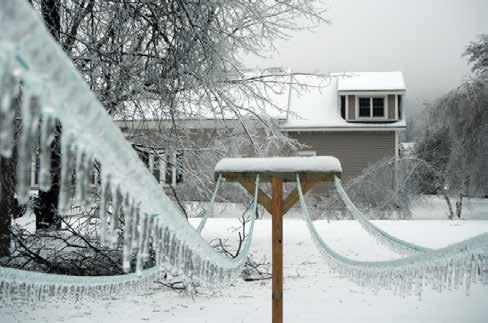
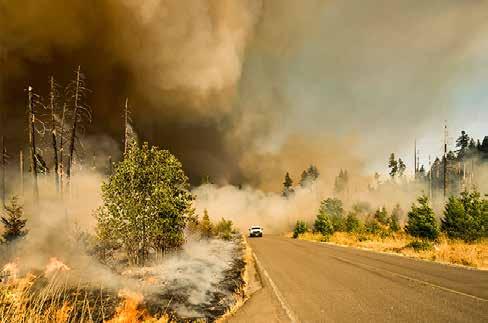
A 6.0 magnitude earthquake is forecasted to hit the Wasatch Front in the next 50 years. (Photo courtesy of SLCEM)
Winter weather provides multiple risks that Salt Lake County residents should prepare for. (Photo courtesy of SLCEM)
Wildfires not only are prone to Salt Lake County foothill areas but also freeway corridors and trailways. (Photo courtesy of SLCEM)
5 habits to start in June for a healthier summer
Get your mind and body in summer mode to enjoy the season.
By Peri Kinder peri.k@thecityjournals.com
June is the perfect time to refresh routines and build healthier habits. Prioritizing well-being will lift your energy and allow you to enjoy activities during the summer months. Starting habits now will create an enjoyable summer where you feel vibrant, engaged and ready to get the most out of every sunshine-filled day.
When starting new habits, start small, stay consistent and be patient. Create a supportive environment and notice the wins. Even accomplishing one goal is a reason to celebrate.
Prioritize hydration. As boring as it might sound, staying hydrated offers myriad benefits. Water increases brain function, assists digestion, alleviates headaches, regulates body temperature and enhances physical performance. Average guidelines show drinking 8-10 cups of water each day is optimal for body and brain function.
To build this habit, purchase a reusable water bottle and set a reminder to drink throughout the day. For added flavor, infuse water with lemon, berries or cucumber. Get a metabolism boost by drinking a cup of water first thing in the morning.
Create a morning movement routine. When you start your day with exercise, the benefits last all day. Morning movement has been shown to raise energy, boost your mood, increase productivity, reduce the risk of disease and


manage weight.
It doesn’t have to be a big time commitment. A 10-minute walk through a local park, a 15-minute online yoga session or five minutes of dancing can set you up for success throughout the day. If you take the practice outside, you get a bonus of sunlight exposure to raise vitamin D levels.
Incorporate fresh foods. Eating fresh produce has to be a conscious choice. Luckily, farmers markets are open again, so finding local food is much easier. Fresh foods are packed with nutrients, lower the risk of chronic disease and taste better than processed foods.
Visit Utahfarmersmarketnetwork.org to find a farmers market near you, then stock up on seasonal fruits and vegetables. Experiment with easy recipes like smoothies, salads and grilled veggies. Work your way up to having half of each meal dedicated to fresh produce.
Create recovery time. As summer activities fill our calendars, we often overschedule our time and end up fatigued. Quality rest is essential to overall well-being, aiding in physical recovery and increased mental health.
Schedule a couple of hours each week where you can do something you love. Maybe it’s hiking, reading, napping or gardening, make sure it’s something enjoyable and not a chore. If you have kiddos, maybe swap a couple of hours of child sitting with a neighbor or family member so you can enjoy a breather without distractions.
Put down the screens. We give our teens grief for scrolling on their phones, but we’re often doing the same thing. Studies show that limiting screen time reduces stress, enhances creativity and enhances focus. We all want to record the fun summer events, like celebrations and va-
MEET DR. HARARAH, M.D.

cations, but looking at the world through a phone screen creates a barrier to real life.
Start small. Make a no-phone rule during meals or family activities (you can take ONE photo if you must), practice having real conversations with people around you, use app blockers, timers and trackers. Summer goes too fast to spend it staring at a phone.
BONUS TIP: Play outside! Warm days call for drinks by the swimming pool, a sunset bike ride, a breakfast picnic, outdoor readathons, pickleball games, paddleboarding, dancing on the patio, fishing in a river and discovering new hiking trails. Slather on the sunscreen and get outside. l
Dr. Hararah, a triple board-certified physician, completed his residency in Family Medicine at NYU Langone and a fellowship in Undersea and Hyperbaric Medicine/Wound Care at SUNY Upstate University Hospital. With additional training in Bariatric Medicine and certification from the American Board of Obesity Medicine, he brings expertise in primary care, dive medicine, bariatric medicine, and clinical hyperbarics.
A firm believer in the biopsychosocial approach, Dr. Hararah views patients as complex individuals whose lives and experiences shape their healthcare. Known for his compassionate care and dedication, he listens intently, prioritizes your well-being, and works to find the best diagnosis and treatment plan.
As the owner of Riverstone Medical, Dr. Hararah is committed to helping you achieve your best health.
OUR SERVICES
Primary Care:
• Annual preventative physical exams
• Cancer screening
• Sick visits
• Specialist referrals
• Medication refills
• Chronic disease management
in Wound
Patients First:
“Dr. Hararah understands the daunting and sometimes demoralizing feelings health care sometimes causes, and wants patients to be truly seen and valued as human beings.” Specializing

Utah’s mountains have hundreds of hiking trails. How many can you explore this summer? (Canva stock)




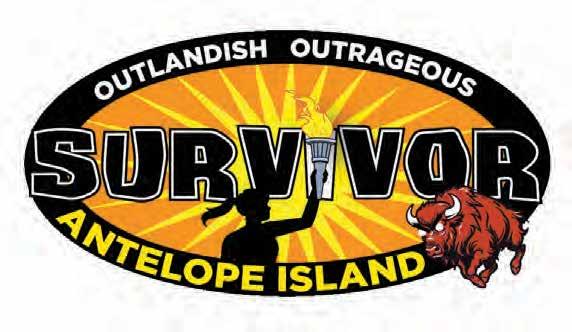


Utah’s Wasatch Front is growing faster than almost any other region in the nation, and nowhere is that more evident than here in Salt Lake County. Today, more than 2.8 million Utahns—over 80% of our state’s population—live along the Wasatch Front and Back. By 2050, we’re on track to nearly double that number, reaching around 5 million Utahns. Protecting the quality of life that drew families, businesses and adventurers to our valleys and mountains in the first place means making smart, coordinated choices right now.
Utah was recently recognized as the best state in the nation by U.S. News & World Report for the third consecutive year. While we have so many great things going for us—a strong economy, volunteerism, social capital and incredible people—one of the things that helps with our success is our willingness to work together.
When it comes to planning for the future, it’s vital that we collaborate at each level of government. I’m proud to be a board member for a planning body that does just this. Wasatch Front Regional Council (WFRC) brings together elected leaders and staff from the state, counties and cities across our region. WFRC ensures that transportation investments, land-use decisions and economic development strategies all align with a shared vision—what we call the Wasatch Choice Vision.
The Wasatch Choice Vision is organized around four key strategies:
1. Real Transportation Choices - Expand travel options beyond the single-occupancy vehicle. By investing in transit, bike networks, sidewalks and more efficient roadways, we help everyone—from commuters to families running errands—get where they need to go safely and affordably.




2. Housing Options for All - Encourage development patterns and zoning that support a wide range of housing types—single-family neighborhoods, starter homes, workforce apartments and townhomes—so that people at every stage of life can find a place to call home that’s close enough to jobs, schools and services.
3. Plentiful Parks and Open Spaces - Preserve and enhance parks, trails and open land for recreation, environmental protection and community gathering. These green assets keep our air and water clean, support mental and physical health, and maintain the outdoor lifestyle Utahns cherish.
4. Vibrant City and Town Centers - Strengthen walkable downtowns and neighborhood hubs where people can live, work, shop and play. By focusing growth in these centers, we relieve pressure on suburban and rural areas, reduce drive times and foster stronger social connections.
No two communities are identical. What succeeds in Sandy or South Jordan might look different than what works in Murray or West Valley City. That’s why WFRC’s member jurisdictions—from the state Department of Transportation to Salt Lake County and its constituent cities—work side by side to adapt the Wasatch Choice Vision’s strategies to local circumstances, ensuring each community charts its own course while staying connected to its neighbors.
Putting the Wasatch Choice Vision into action will have concrete impacts right away—and pay dividends for decades: more jobs, conserved open space, less water used, billions saved in infrastructure costs, and reduced household budgets through more housing and transportation options. This translates to stronger communities, healthier families and a sustainable economy that can thrive even as we welcome more neighbors—along with our children and grandchildren—to our mountain valleys.
None of this would be possible without the active partnership of the state, county planning commissions, city councils, transit agencies, business associations and civic groups. Through WFRC, these diverse interests come together at the same table—an inclusive forum where big-picture goals align with local aspirations.
I’d encourage you to learn more about the Wasatch Choice Vision. Our region’s future quality of life depends on informed, engaged residents—and on leaders who listen, collaborate and act. Visit wfrc.org to see the Vision and learn more about how to stay informed. l























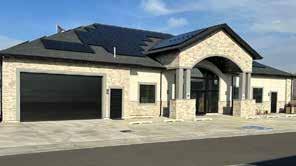














A Puppet Regime
It took decades, but Ronald Grump finally found a way to evict the residents of 123 Sesame Street. Grump (played by Joe Pesci) visited the TV show in 1994 with plans to demolish the beloved neighborhood to build Grump Tower.
Sesame Street doubled-down in 2005 when a selfish, orange-haired muppet, Donald Grump, tried to hire an apprentice to help with his trash empire. In the episode, Oscar the Grouch sings about Grump, “Whose name equals trash, to you and to me?”
Maybe he holds a grudge, but a U.S. president with a similar name signed an executive order to cut funding for PBS, a nonprofit provider of educational shows like Arthur, Elmo’s World and Sesame Street.
The move could throw the Muppets into the gutter. Bert will have to sell his paper clip collection, Elmo will be forced to pawn his tricycle and Count von Count will have to join an accounting firm.
From the beginning, Sesame Street championed diversity, equality and inclusion: three things the current administration is gleefully destroying. Humans on the show included Gordon and Susan (a Black couple), Maria from Puerto Rico, Luis from Mexico and the elderly Mr. Hooper, who was Jewish and ran the corner store.
The multicultural cast attracted big guest stars. Carol Burnett, Stephen Curry,


Peri Kinder Life and Laughter

Robert De Niro, Billie Eilish and James Earl Jones are just a few celebrities who visited Sesame Street, proving you’re never too famous to be silly.
Not only does the show teach children basic reading and math, it also teaches cooperation, respect and kindness. It’s tackled divorce, same-sex marriage, racial literacy, anger, sadness and even has a Muppet whose parent is incarcerated. The show never talks down to children.
When Will Lee died, his Mr. Hooper character died with him, leaving Big Bird distraught as his friends tried to explain the concept of death. That episode won an Emmy, one of more than 120 Sesame Street has collected.
Sesame Street has its furry finger on the pulse of American culture. The show is as much for parents as for kids. My favorite characters are the loveable Grover and Guy Smiley, the enthusiastic gameshow host.
I can still sing the show’s theme song,

along with “Rubber Duckie,” “I Love Trash,” “Doin’ the Piegeon” and hundreds of tunes from the show. I couldn’t begin to choose a favorite skit but I always loved the baker falling down the stairs. That remains my level of humor maturity.
The show is iconic. Big Bird is an international star. He visited Michelle Obama at the White House, made the cover of Time magazine, has a star on Hollywood’s Walk of Fame and his picture on a postage stamp. I spent several months cross-stitching Big Bird’s face on a Christmas advent calendar our family still uses nearly 40 years later.
Maybe it’s because Muppets don’t vote. Maybe it’s because Oscar started teaching kids about recycling. Maybe it’s the Sesame Workshop’s mission statement, “Helping
children everywhere grow smarter, stronger, and kinder.” Maybe the president just doesn’t like watching people have fun. My husband and I paid thousands of dollars in federal taxes this year, but if funding is cut for things I value, like PBS, science, national parks, higher education, Head Start programs and world health initiatives, maybe I don’t have to pay taxes anymore. I mean, seeing all these tax-free billionaires… tax evasion isn’t a crime anymore, right?
Sesame Street promotes kindness and community, while the president seems to only find value in wealth and power. As he said in 2011, “Part of the beauty of me is that I am very rich.” For anyone who’s ever loved Sesame Street, beauty has a much deeper meaning.







